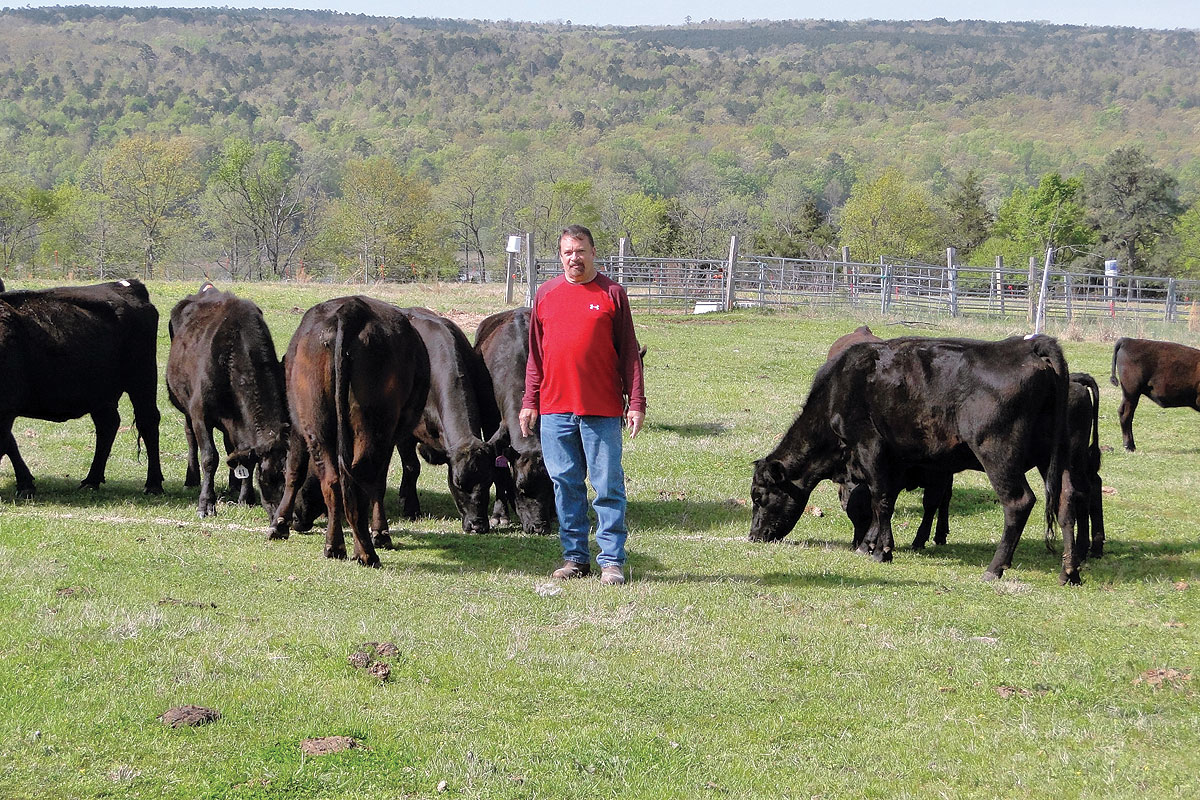
Tom and Jana Jones are town folk living in the Little Rock, Ark., area. Tom is a senior environmental health specialist who manages funds from the U.S. Fish and Wildlife Service and is involved in anything that has to do with moving marine sewage ashore. Meanwhile, Jana is a medical assistant for an orthopedic surgeon. The couple has two children and four grandchildren.
A favorite memory centers around 6-year-old cousins who were all decked out in their Carharts and watching Tom performing artificial insemination in a corral. The older, by two months, was explaining to the younger who exclaimed, “What the heck!” Needless to say, Tom had to smother his laughter.
In 1987, Tom purchased 31 acres in Piney, Ark., in Johnson County on which he established Riverview Angus Ranch.
Tom and Jana raise registered black Angus breeding stock with the commercial breeder as the first target buyer. He moved their herd to this area for security reasons, as well as to expand the operational herd to 30 with the 60 acres in Woodland, Ark., to be used for hay production and family hunting.
In recent years, the Piney farm became as drought stricken as Texas and Oklahoma, forcing him to start feeding hay in May. He had installed three waterers using rural water a few years before the drought hit.
“Here public water is cheaper than well water, and I had fenced off my pond to be environmentally correct from cattle pollution, and to provide my cattle with high quality non-polluted water,” Tom explained.
Tom attributes his herd’s ability to survive the drought years to having a belly full of good, cold water from the automatic waterers.
A second important consideration for Tom is his feeding regimen, which does not follow the conventional high-protein diet. Tom strives for a balance of protein, fiber and fat that he believes creates the highest quality breeding animal.
“I believe my cattle need a high fat intake rather than a high-protein diet and I use a liquid feed called Mix 30, so the cattle have more energy, with the fat being the limiter on their intake of the liquid feed,” he said.
The product looks like chocolate milk and when used with hay has allowed his cattle to survive the drought.
According to Tom, protein builds muscle, but too much protein eliminates the fat needed to produce the best conditioning in cattle. Tom also feeds high-fiber soybean hull pellets and a peanut product called Nut Grub. He uses the dry matter intake (DMI) information from the American Angus Association, which predicts easy-keeping mothers. Logic says calves are equally influenced by each parent.
Tom, however, believes the influence is more like a 60-40 percent influence with the cow being more influential, perhaps partially attributable to the fact that the momma raises the calf and provides its initial nutrition.
Tom’s third priority is breeding. “One time an old fella told me that the best advice is to breed extreme,” Tom said. What this means in practical terms is that Tom wants a low maintenance momma which is generally short framed and thick. This kind of cow produces excellent calves when combined with a high-performance, larger-framed, extreme bull. He will eventually cull females who produce too much milk because they recover from calving and nursing more slowly and do not generally breed back quickly enough to have one calf a year.
Ninety percent of his mommas are bred by artificial insemination or are embryo transplants, with the other 10 percent bred by a cleanup bull.
From a financial standpoint, the herd can be bred by high-powered genetics without the cost of maintaining and rotating high-dollar bulls. Tom searches for genetics with a negative DMI, but strong traits for frame and muscle, the extreme he prefers. “I have several older Angus bulls’ semen not available on the market anymore which has become an asset,” Tom said.
Tom and Jana’s herd produces calves with an average birth weight of 73 pounds, but grow quickly and effectively to a weaning weight at 7 months of age with a 600-pound average. A specific example of Tom’s breeding program is an OCC Anchor x New Design 1407 cow bred to the extreme B/R Ambush 28 bull. The result was a bull calf that was bigger than its mother when weaned.
Tom has other routine procedures. He switches between long range and pour on wormer as much as possible to maintain effectiveness. In addition, he is a firm believer in Multi-Min, an injectable mineral.
The Jones farm is common Bermuda grass/white clover based, and over seeded with arrowleaf clover. He prefers fertilizing with urea because the land requires less use of herbicide, since chicken litter contains some unwanted weed seeds.
Tom’s parents and grandparents moved from the country because they wanted an easier life. They thought Tom was crazy for going into cattle in 1980. Without a strong, practical farming background, Tom learned a great deal from his veterinarian brother, Neal, and from practical experience. Among those pertinent routines are making sure to vaccinate for black leg, not overfeeding in order to avoid feet issues, and paying very close attention to what the cattle eat during a drought.
“I learned that the last plants to die during a drought tend to be poisonous,” Tom said.
A specific plant is perilla mint, a square stemmed mint with lavender backed leaves which are green on the sun side. The plant is generally one to two feet tall, grows in the shade, and is something Tom and Jana watch for. Needless to say, Tom’s biology background is a huge help.
Tom is planning to retire in four years, when he intends to focus more on their herd. Tom and Jana are considering expanding their cattle base and are looking forward to having more time with their grandchildren being around the cattle. They believe strong exposure to an agricultural life will make them more well-rounded people.






